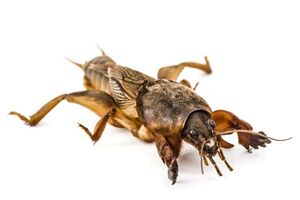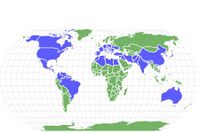Mole cricket
Mole crickets are fossorial insects belonging to the order Orthoptera and family Gryllotalpidae, spending most of their life underground. [1] Mole crickets encompass seven genera and contain about 100 species worldwide. [2] Their specialized forelegs allow them to dig and construct burrows in the soil. Their burrows are carefully constructed and serve a variety of purposes. [1]

| |
| Kingdom | Animalia |
|---|---|
| Phylum | Arthropoda |
| Class | Insecta |
| Order | Orthoptera |
| Family | Gryllotalpidae |
Anatomy
Different species have slight variations in anatomy. The mole cricket possesses two pairs of legs that resemble a cricket as well as a pair of forelegs that closely resemble those of moles and are specialized for digging burrows. Their skin is able to prevent adhesion by moist soil during the digging process because of a thin layer of down on the mole crickets' body. [5] Antennae serve as the mole cricket's main olfactory organ and also serve as gustatory and mechanoreceptors. [6] Further, these antennae aid in warning mole crickets of approaching danger. The mole cricket's safety is further assured by its brown hue which allows it to blend into the soil. Most mole crickets species possess two pairs of wings that allow adults to fly short distances.[5] However, some species of mole cricket, like the shortwinged mole cricket do not grow wings large enough to support flight. [7] The body of the mole cricket can be broken down into three main parts which include the head, thorax, and abdomen. [5]
Habitat and Distribution

Mole crickets live most of their life in the soil in burrows that average about 1/2 inch in diameter. [9] Various species of mole crickets can be found on every continent except Antarctica. They can be found in any location with moist, loose soil. [8] However, they show a preference for sandy soil. They can often be found within the vicinity of meadows and fields, specifically of corn and barley. [5] Mole crickets are rarely seen by people because of their underground habitat and nocturnal tendencies. [9]
Diet
The diet of different species of mole crickets can vary, but many will feed on both plant and animal matter. Mole crickets will build their burrows in order to suit their diets. Herbivorous species will construct shallow burrows to feed on roots and grasses, while primarily carnivorous species dig deeper burrows to search for prey. [10] The Tawny mole cricket and African mole cricket are examples of herbivorous species, while the Southern mole cricket is predominantly carnivorous. [1] Vegetable crops, worms, larvae, and insects are also food options for most species of mole cricket.[11] It is not uncommon for some species to attack others and engage in cannibalistic behaviors. [5]
Life Cycle & Reproduction

The life cycle of the mole cricket follows incomplete metamorphosis. Individuals grow from egg to nymph to adult. The life cycle of a mole cricket lasts from 1-3 years with about 1 generation of mole crickets being produced per year. [12] Mole crickets reach maturity in spring and early summer in the months of April and May. It is at this time that eggs are produced. Females deposit eggs into underground burrows between 5 and 30 centimeters deep. Females produce a mean of 4.8 egg clutches in their lifetime. Each egg cluster consists of 25 to 60 eggs and individuals spend 10 to 40 days in this stage. Nymphs resemble adult mole crickets but are smaller and lack developed wings. During the summer months, nymphs progress through approximately 8 to 10 stages of development. [11] Adult mole crickets have fully developed wings and specialized forelegs that allow them to dig extensive burrows and fly, typically at night.
Pest Control
References
- ↑ Jump up to: 1.0 1.1 1.2 Endo, Chihiro. “The Underground Life of the Oriental Mole Cricket: An Analysis of Burrow Morphology.” Journal of Zoology 273, no. 4 (2007): 414–20. https://doi.org/10.1111/j.1469-7998.2007.00345.x.
- ↑ Ingrisch, Sigfrid, and D.C.F. Rentz. “Orthoptera: Grasshoppers, Locusts, Katydids, Crickets.” Essay. In Encyclopedia of Insects, Seconded., 732–43. Academic Press, 2009.
- ↑ “Mole Cricket Control in Lawns and Turf.” ngturf.com, April 2022. https://ngturf.com/mole-cricket-control-in-lawns-and-turf/.
- ↑ “Gryllotalpidae.” itis.gov, n.d. https://www.itis.gov/servlet/SingleRpt/SingleRpt?search_topic=TSN&search_value=102369#null.
- ↑ Jump up to: 5.0 5.1 5.2 5.3 5.4 Kidd, John. “On the Anatomy of the Mole-Cricket.” Philosophical Transactions of the Royal Society of London 115 (1825): 203–46. https://doi.org/10.1098/rstl.1825.0012.
- ↑ Kostromytska, Olga, Michael E. Scharf, and Eileen A. Buss. “Types and Functions of Mole Cricket (Orthoptera: Gryllotalpidae) Antennal and Palpal Sensilla.” Florida Entomologist 98, no. 2 (2015): 593–605. https://doi.org/10.1653/024.098.0232.
- ↑ “Basic Biology of Mole Crickets.” entnemdept.ufl.edu, n.d. https://entnemdept.ufl.edu/molecrickets/MCRI0201.HTM.
- ↑ Jump up to: 8.0 8.1 “Mole Cricket.” azanimals.com, 2021. https://a-z-animals.com/animals/mole-cricket/.
- ↑ Jump up to: 9.0 9.1 “Mole Cricket.” texasinsects.tamu.edu, n.d. http://texasinsects.tamu.edu/mole-cricket/.
- ↑ Li, Tongchuan, Ming’an Shao, Yuhua Jia, Xiaoxu Jia, and Laiming Huang. “Small-Scale Observation on the Effects of the Burrowing Activities of Mole Crickets on Soil Erosion and Hydrologic Processes.” Agriculture, Ecosystems. and Environment 261 (2018): 136–43. https://doi.org/10.1016/j.agee.2018.04.010.
- ↑ Jump up to: 11.0 11.1 Capinera, John L, and Norman C Leppla. “Featured Creatures.” entnemdept.ufl.edu, 2001. https://entnemdept.ufl.edu/creatures/orn/turf/pest_mole_crickets.htm.
- ↑ Jump up to: 12.0 12.1 “Mole Cricket ID.” syngenturf.ae, n.d. https://www.syngentaturf.ae/mole-cricket-id.